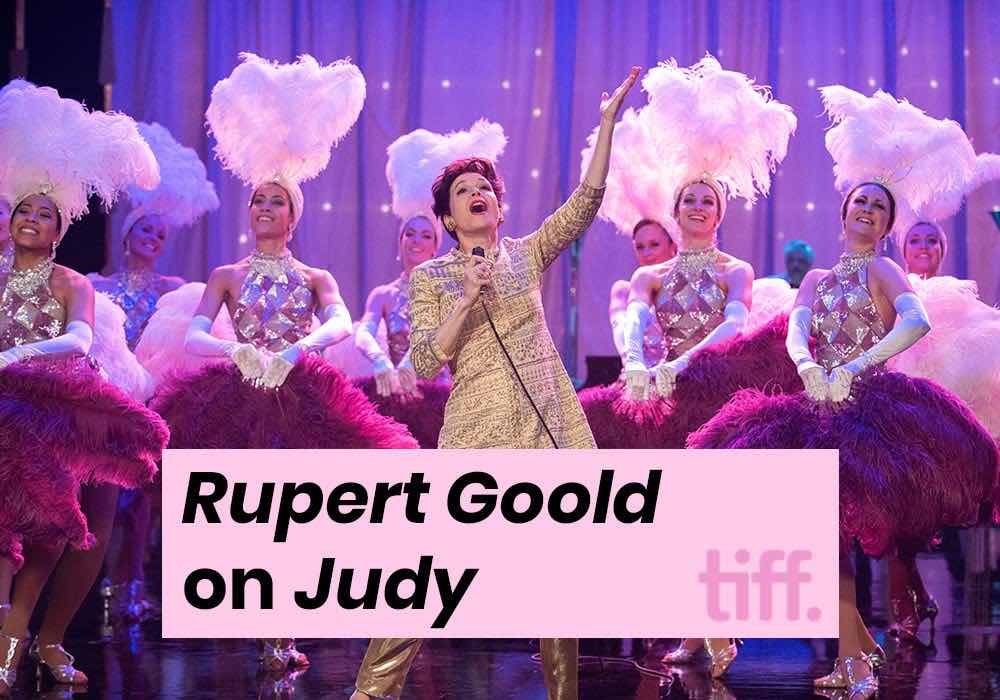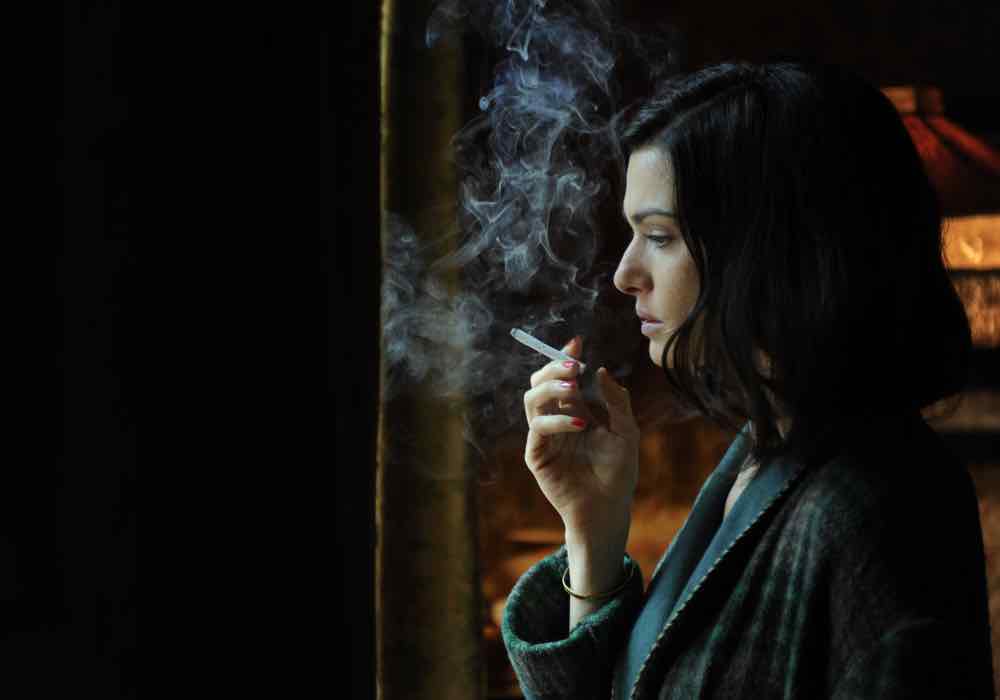On the 70th anniversary of Joseph Mankiewicz’s All About Eve, we dissect Ivo Van Hove’s recent stage revival, and its use of the ‘cinematic’ closeup with on stage cameras.
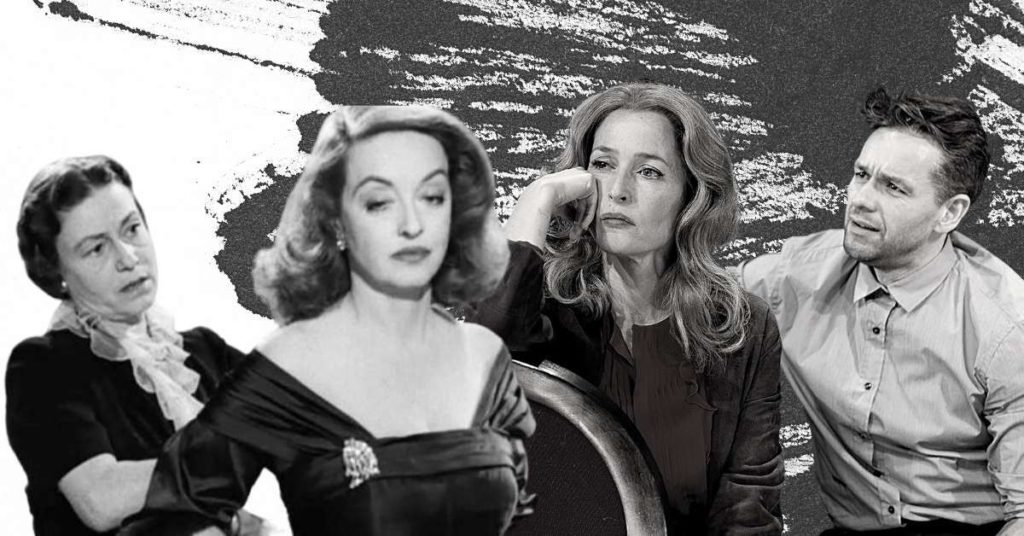
Discover one film you didn’t know you needed:
Not in the zeitgeist. Not pushed by streamers.
But still easy to find — and worth sitting with.
And a guide to help you do just that.
All About Eve is a story of personas, imagined and real. In Ivo Van Hove’s recent stage revival of this tale of bitter backstage rivalry, an early scene highlights fading theatre star Margo’s (Gillian Anderson) neverending performance. Margo sits facing the mirror at a dressing table centrestage, her back to the audience and to the entourage who flock in and out. Anderson performs looking into a camera hidden inside the mirror as she puts on her makeup, the entire process of ‘becoming’ Margo projected in closeup on a giant screen above her. But rather than ‘unmasking’ Margo, this device adds another level of performance, another surface blocking the viewer from Margot’s interiority.
Such are the contradictions of Van Hove’s large-scale experiments with style. Since his View From the Bridge, played in the round with operatic staging, the Belgian theatre director has become a marquee name in British theatre. His ambition for accessible takes on recognisable properties includes adapting Bowie’s music for the theatre in Lazarus, and updating operatic works by Cassavetes and Visconti. This has made his productions easier to sell in a West End currently dominated by glitzy movie adaptations.
In adapting a well-known film for the stage, Van Hove confronts the relationship between different media forms while capitalising on the IP. Van Hove has often used on-stage cameras to explore fame and celebrity, such as in his recent Lazarus and Network. Then there’s his appreciation for a naturalistic acting style that shows off the chops of his famous actors — and they’re always famous. Van Hove uses star personas to blow up the scale of his productions, from Jude Law to Bryan Cranston to the pairing of Gillian Anderson and Lily James in his latest production: an adaptation of Joseph Mankiewicz’s classic Hollywood film All About Eve. Using large projections to invade his characters’ personal space, he magnifies their onstage psychologies. Surely, his explorations of celebrity personas would find their ultimate source material in All About Eve, with a true hybrid of film and theatre.
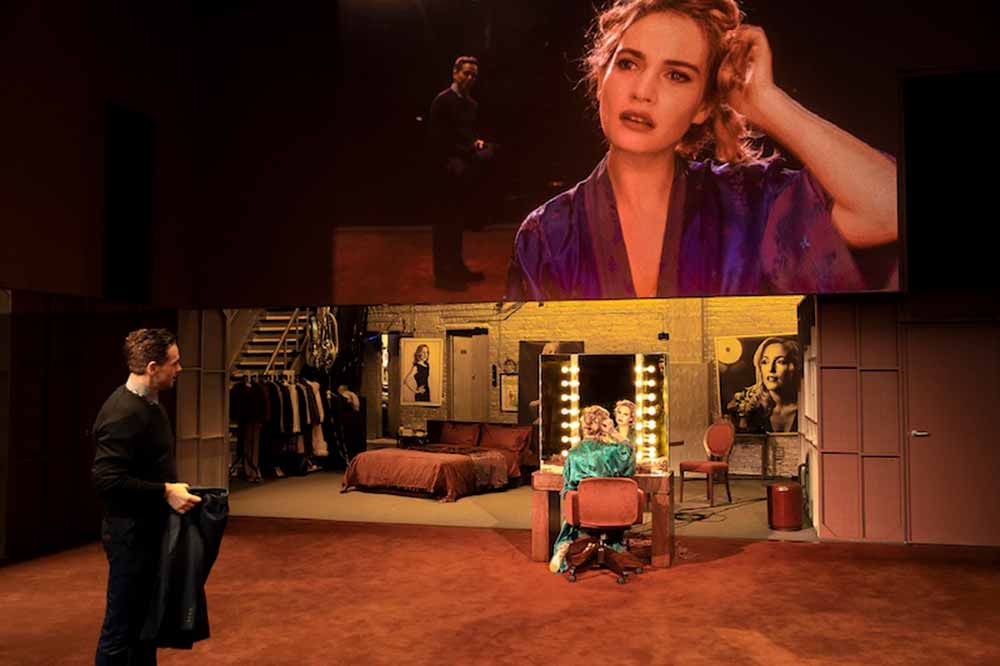
Still considered a classic, the modern reputation of Mankiewicz’s 1950 film version of All About Eve revolves more around its quotable dialogue and catty put downs than its dramatic weight. Based on a short story by Mary Orr, it tells of the aging Broadway star Margo Channing (played with iconic relish onscreen by Bette Davis) who is usurped by the younger model: purported superfan Eve Harrington (Anne Baxter). Eve shows up in Margo’s dressing room with a hard-luck backstory and then worms her way into every cranny of Margo’s life, eventually becoming her understudy and essentially taking over Margo’s career. It’s a story of contrasts between public and private behaviour, about growing or outgrowing showbusiness personas.
On stage, All About Eve attempts to reassert the seriousness of the story through Van Hove’s trademark sparse sets and muted lighting — which create a tone of artful sophistication — and by foregrounding allusions to #MeToo. These elements are parts of a project that repeatedly claims this story has contemporary importance. But while the dialogue is largely unchanged from the original screenplay, Van Hove encourages a modern acting style which recasts the material — not wholly successfully. The delivery speeds the pace but comes across as an attempt to hide the script’s anachronistic mannerisms, as though anxious of its age. The cast perform a modern reading of old dialogue, presenting as self-aware characters who never stop performing whether onstage or off. They may be backstage, but they still perform their lives to each other from the green room. It makes for an endless expression of fakery and persona — and a mismatch of language and delivery that makes the play’s bid for contemporary relevance feel even more antiquated.
Characterisation is muddled by Van Hove’s use of modern technology to update a familiar Hollywood legend. Van Hove’s stage production marries film and theatre by taking the Broadway scenes out and putting closeups in. Mankiewicz’s film shows scenes of Margo and Eve acting onstage, but Van Hove sets his play almost entirely backstage in Margo’s dressing room. We lose something here: when Davis/Margo mugs as a young lady in her play Aged in Wood, her desperation not to act her age is made visible without dialogue. Without this, Van Hove’s audience is left to infer the extent of Margo’s star power, and must take on faith Eve’s strength as a young up-and-comer. Instead of a stage-within-a-stage, space above the set is occupied by a movie screen showing live projections of characters reacting, or monologuing, or doing something unrelated offstage. Van Hove relies on the camera to fill those absent spaces with the faces of the cast, who are left trying to perform to both a stage and a camera — confusing both.
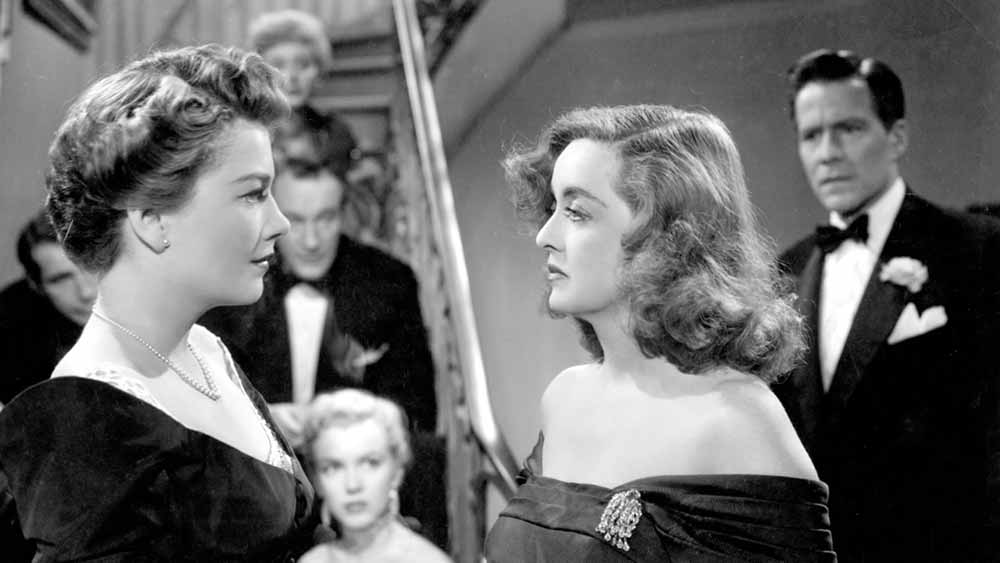
Though lighting and blocking can draw our attention onstage, cinema is unique in that our eye sees exactly what the director chooses. More than any other type of shot, the closeup restricts our view to a single subject. It eschews background information for the details of an object or a person, brings us directly into contact with the subject, providing closer emotional engagement or restricting knowledge by showing just one thing. It inherently makes private into public by magnifying faces and projecting them to space as big as the stage. The film version of All About Eve has very simple, precise blocking and framing to make the power dynamics of each scene immediate. Mankiewicz knows to put Margo front and centre-frame, with Davis in a relaxed posture when she’s in her dressing room, and increasingly out of centre as she loses her grip.
Gillian Anderson’s approach to Margo purposely inverts some of Davis’ gestures, but her performance is hampered by Van Hove’s conceit. When to go big or small is inverted by the parameters of the production, to the effect that the fabulous Gillian Anderson presence is aimless. Margo’s self-destructive tendencies are brought organically into 2019 by openly being fueled by depression and addiction. In the central party scene, for instance, while the ensemble publicly discusses Margo’s state of mind, the audience sees her in the bathroom, vomiting. Ironically, the camera makes a performance out of an aspect of Margo’s personality that she would desperately keep quiet. In blowing up that image we are invited to gawp at the TMZ-like abjection of the moment. Elsewhere, Anderson drowns Bette Davis’ most famous line, ‘Fasten your seatbelts, it’s gonna be a bumpy night’. Davis made a meal out of the line, but Anderson’s delivery isn’t big enough for stage or screen. Subtlety of expression onstage does not necessarily communicate as it would in film, and so placement of the camera in front of Anderson is not necessarily enough to let us into the true Margo persona.
Van Hove only attempts to control our eyeline on the screen by using closeup. The result is neglectful of the stage itself, which often looks jumbled and ill orchestrated. There seem to be no rules for the interaction between on/offstage space and performance. The general approach seems to be filming public space offstage, and having private moments onstage. If the intention is to spread the space, unbinding the audience and actors from the limits of the proscenium, the result is dead air. Where an entire party might be taking place onscreen, the stage is empty and still. It leaves actors adrift, miming conversation without any progression, literally waiting for their closeup.
In contrast, the closeups in Mankiewicz’s film aren’t oppressive. It’s mostly comprised of mid-shots, but choices of when and how to frame a closeup draw our attention to facial gestures. For instance, early in the film Margo’s friend Karen (Celeste Holm) invites Eve to meet Margo backstage, saying ‘She’s got to meet you.’ The camera on Karen, glides so that shadow crosses her face, making her eyes bold, as if fate is compelling the meeting with Margo.
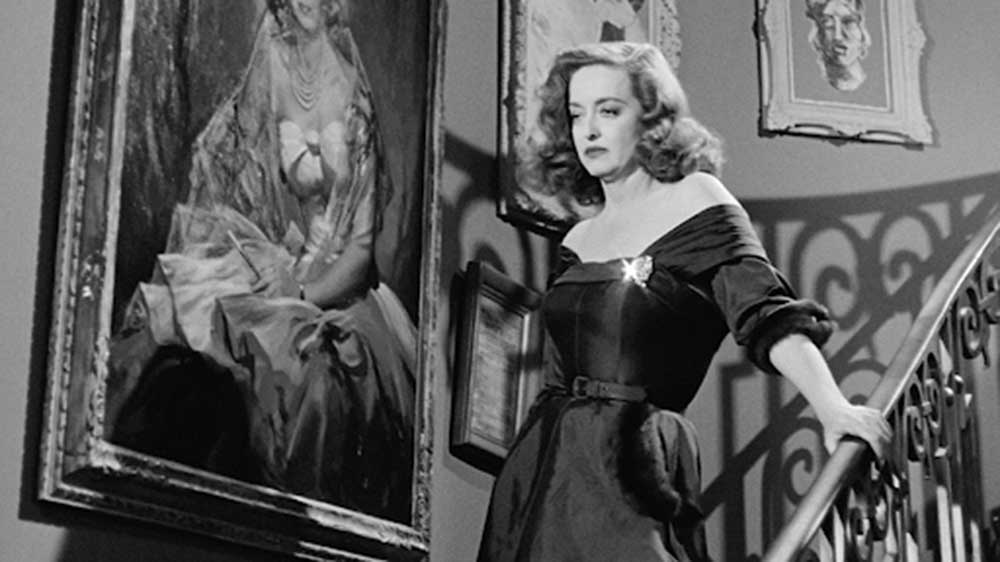
That use of shadow is a theatrical trick. On stage, we select our own closeups by using our eyes to focus around the stage; our audience perspective allows us that autonomy. But Van Hove’s sheer commitment to using the screen in every scene, when it often isn’t used to enhance or juxtapose the action, robs the audience of this. Closeups of innocuous props detract from the energy of the scene. While the stakes couldn’t be higher for Margo and Eve as bombshells are dropped during the climactic restaurant scene, the camera crew focus on a set of ornate candlesticks, moving around them like Terrence Malick would a pair of lovers. If the focus on these candlesticks is to highlight that the setting drips with wealth, then costumes and other visible props have already done this. Without any clear link to the scene, it pulls the audience from one of the play’s big dramatic moments. The closeup, instead of confining our attention, loses it.
Beyond the extended restaurant scene, the drama is regularly confined to the private setting of backstage, where Van Hove attempts to reframe All About Eve as a commentary on Harvey Weinstein and other Hollywood abuse stories. Both versions of All About Eve are framed by a columnist’s narration. With New York just beyond the boundaries of the stage, Eve is blackmailed by theatre critic Addison into an unwanted relationship. Addison plainly has far more power than any culture commentator today (even Kael would quake), whose omniscience belies a mythic element to abuse in showbusiness. Addison knows everyone’s private lives, their futures and pasts, better than they can themselves. Although the flippancy with which this plotline is handled in the 1950 film is at least accounted for by its era, the play is ill-equipped to reckon with it. Addison hides among the audience like a panto villain, listening to Eve’s attempted seduction of playwright Lloyd Richards, which he then uses against her. This moment longs for a closeup to make on and offstage space interact, public bursting into the private. It might function as an edit, like how Mankiewicz uses the Kuleshov effect to build tension in that moment’s filmic equivalent.
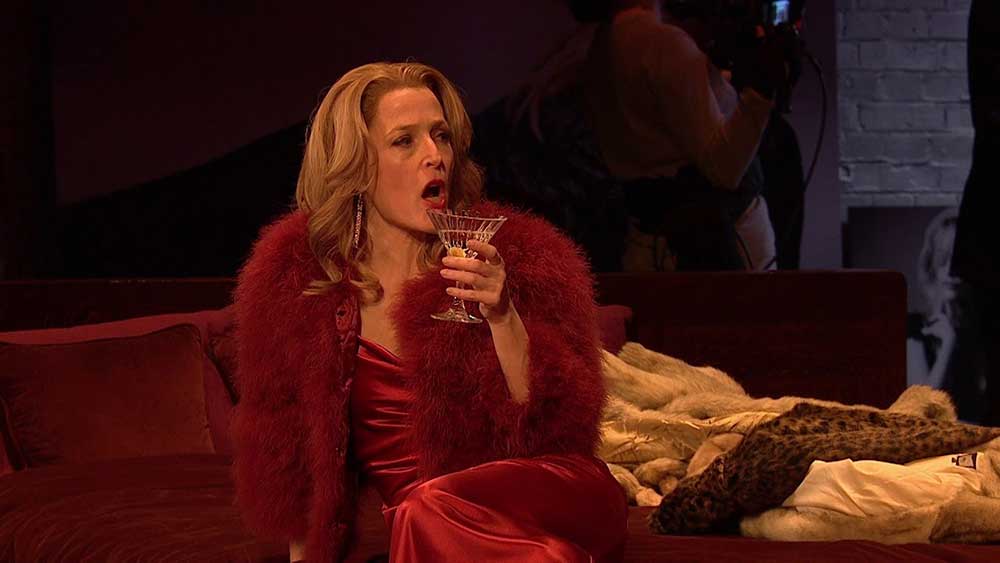
Van Hove’s All About Eve uses the language of the closeup with regularity, but doesn’t exploit the other vast opportunities of the camera onstage. This missed opportunity begs the formal purpose of the entire production. If it’s modernisation, why is this plotline so flatly presented, with the emphasis still on Eve’s deception, rather than victimhood that might have led to her bitter cynicism? If it’s a straight adaptation of a ‘50s script with dated politics, then why attempt the modern style at all?
Perhaps it is Eve herself who is misrepresented by the play. Anne Baxter as Eve 1950 transmits a sinister coldness, which Lily James just translates as introversion. Thus Eve the usurper is hidden. Eve watches Margo perform every night, cries every time. She has studied performance and studied Margo. “There are some human experiences that don’t take place in a vaudeville house,” she says, performing from minute one. Her trench coat mirrors her character: her personality hidden, neutralised by a single plain costume which hides her true interior.
Anne Baxter spends much of the film watching. She is often specifically framed to take up a large portion of the screen, which laces ideas of voyeurism and persona into the text. But the stage camera does not pick Eve out in the large ensemble scenes, as Altman might, so her perspective is withheld. That is, until the revelation of her true motivations, by which time the camera is trained on Lily James. Suddenly, the actor comes alive, having been blocked to sink into the background for so long. By condemning Eve to the background throughout the first half of the play, Van Hove skips the tragic inevitability of her usurpation of Margo. By skimping on Eve’s arc and keeping her out of the closeup, the tension of her rise doesn’t contrast with the pain of Margo’s downfall, leaving nothing but a contrived plot maneuverance.
This flaw is a directorial choice: the production lets James down by positioning Eve unremarkably, even nonchalantly within the ensemble. This nonchalance spreads throughout the production. Nonchalance with regard to updating the politics. Nonchalance for the interior of Margo’s ‘grand dame’ persona. And, most tellingly, nonchalance for the positioning, framing, and timing of Van Hove’s biggest formal device, the closeup. This carelessness makes one question the purpose and possibility of the theatre’s use for the camera, and the artistic prospects of translating classic Hollywood to the stage.
You could be missing out on opportunities to watch great livestreamed theatre, as well as films in virtual cinemas and festivals.
Subscribe to the Seventh Row newsletter to stay in the know.
Subscribers to our newsletter get an email every Friday which details some of the best new streaming options in Canada, the US, and the UK.
Click here to subscribe to the Seventh Row newsletter.
